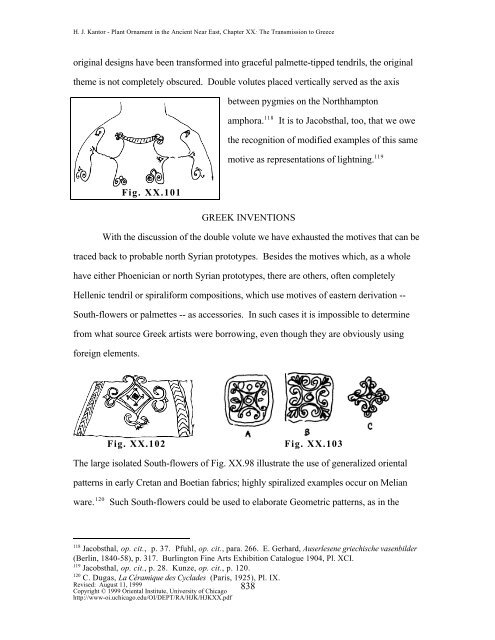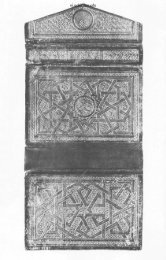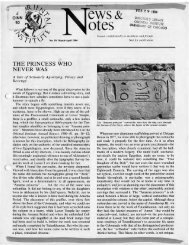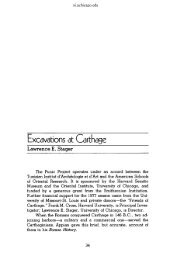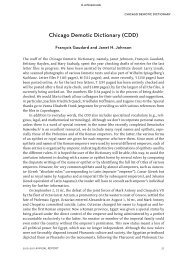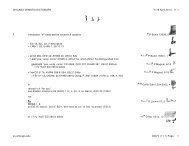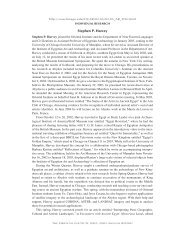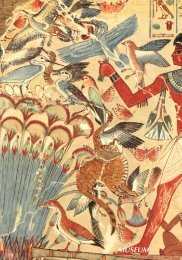chapter xx. the transition to greece - Oriental Institute - University of ...
chapter xx. the transition to greece - Oriental Institute - University of ...
chapter xx. the transition to greece - Oriental Institute - University of ...
You also want an ePaper? Increase the reach of your titles
YUMPU automatically turns print PDFs into web optimized ePapers that Google loves.
H. J. Kan<strong>to</strong>r - Plant Ornament in <strong>the</strong> Ancient Near East, Chapter XX: The Transmission <strong>to</strong> Greece<br />
original designs have been transformed in<strong>to</strong> graceful palmette-tipped tendrils, <strong>the</strong> original<br />
<strong>the</strong>me is not completely obscured. Double volutes placed vertically served as <strong>the</strong> axis<br />
between pygmies on <strong>the</strong> Northhamp<strong>to</strong>n<br />
amphora. 118<br />
It is <strong>to</strong> Jacobsthal, <strong>to</strong>o, that we owe<br />
<strong>the</strong> recognition <strong>of</strong> modified examples <strong>of</strong> this same<br />
motive as representations <strong>of</strong> lightning. 119<br />
Fig. XX.101<br />
GREEK INVENTIONS<br />
With <strong>the</strong> discussion <strong>of</strong> <strong>the</strong> double volute we have exhausted <strong>the</strong> motives that can be<br />
traced back <strong>to</strong> probable north Syrian pro<strong>to</strong>types. Besides <strong>the</strong> motives which, as a whole<br />
have ei<strong>the</strong>r Phoenician or north Syrian pro<strong>to</strong>types, <strong>the</strong>re are o<strong>the</strong>rs, <strong>of</strong>ten completely<br />
Hellenic tendril or spiraliform compositions, which use motives <strong>of</strong> eastern derivation --<br />
South-flowers or palmettes -- as accessories. In such cases it is impossible <strong>to</strong> determine<br />
from what source Greek artists were borrowing, even though <strong>the</strong>y are obviously using<br />
foreign elements.<br />
Fig. XX.102<br />
Fig. XX.103<br />
The large isolated South-flowers <strong>of</strong> Fig. XX.98 illustrate <strong>the</strong> use <strong>of</strong> generalized oriental<br />
patterns in early Cretan and Boetian fabrics; highly spiralized examples occur on Melian<br />
ware. 120<br />
Such South-flowers could be used <strong>to</strong> elaborate Geometric patterns, as in <strong>the</strong><br />
118<br />
Jacobsthal, op. cit., p. 37. Pfuhl, op. cit., para. 266. E. Gerhard, Auserlesene griechische vasenbilder<br />
(Berlin, 1840-58), p. 317. Burling<strong>to</strong>n Fine Arts Exhibition Catalogue 1904, Pl. XCI.<br />
119<br />
Jacobsthal, op. cit., p. 28. Kunze, op. cit., p. 120.<br />
120<br />
C. Dugas, La Céramique des Cyclades (Paris, 1925), Pl. IX.<br />
Revised: August 11, 1999<br />
838<br />
Copyright © 1999 <strong>Oriental</strong> <strong>Institute</strong>, <strong>University</strong> <strong>of</strong> Chicago<br />
http://www-oi.uchicago.edu/OI/DEPT/RA/HJK/HJKXX.pdf


